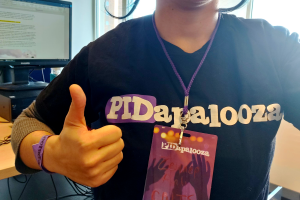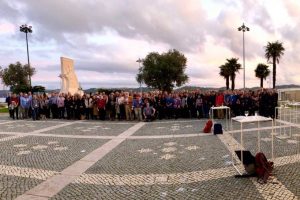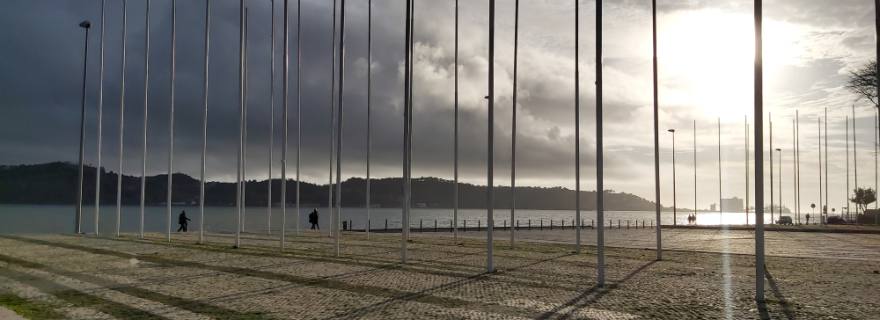PIDapalooza 2020, Lisbon
At the end of January, I went to the PIDapalooza festival: the open festival of persistent identifiers. You can read everything about my experience in this post.
Taking place in the beautiful sunny Lisbon, PIDapalooza 2020 feels like a festival from the start. With free festival t-shirts, wrist bands and a Nails and Instant Tattoos corner, participants easily got into the fun mood of the event. Some of those who have attended the previous editions of the event were wearing festive hats and t-shirts from the previous edition of the festival. I also picked up my first PIDapalooza merch.

Maybe some readers are not familiar with what PID stands for, so I will give a brief explanation. PID or PI, persistent identifier, is a long-lasting reference to a digital item. Some examples could be ISBN, ISSN and DOIs. PIDapalooza is a festival that has been organized by experts from California Digital Library, Crossref, DataCite and ORCID. The event responds to the need for a platform where researchers and stakeholders working on PIDs can gather and exchange ideas.
The welcome speech on the first day was accompanied by Salvador Sobral’s Eurovision winning song Amar Pelos Dois, played live on stage with a guitar. This lovely treat was followed by the organizing board lighting an Olympic torch while Eternal Flame by The Bangles played in the background. That torch stayed lit in the main conference hall throughout the event as a light-hearted symbol of the festival.
The first keynote address, given by Maria Fernanda Rollo, provided us with valuable insight on the use of persistent IDs within the education system of Portugal. Parallel sessions continued to reflect the lively spirit of the festival. To give a couple of examples, it was a pleasure to follow the FAIRytale presentation of Stephanie van de Sandt with delightful drawings, interactive multiple-choice questions and captivating narratives. Gaelle Bequet’s presentation featured a jazz quiz and the audience had to guess the musician and name of the track. The Research Organization Registry (ROR) team wore lion masks as they organized a group drawing activity for the audience.
In the second half of the first day, the presentation of European Open Science Cloud (EOSC) FAIR1 Working Group, part of the European Open Science Cloud Governance, was quite insightful as they are developing a policy concerning the use of PIDs to support FAIR research. In the second keynote of the day, Beth Plale, from the National Science Foundation, talked about persistent IDs in relation to open science. The day ended with a lively reception, a group photo and a quiz.

On the second day, morning presentations focused more on methodologies and tools specifically designed for data harmonization, while the afternoon presentations included more group activities, interactive participation and a party attitude. In the morning, I attended the presentation of Richard Wynne, who introduced the tool Rescognito which concentrates on researcher recognition and the presentation of Tommi Suominen, who showed us PID examples and methodologies from the Finnish Research Information Hub. Both were quite insightful and informative.
The last keynote of the festival, given by Kathryn Kaiser, lifted the post-lunch mood of the audience. Kaiser threw a glittery unicorn beach ball into the audience and we played with it until everyone touched it.
We are definitely all awake and energized after this fun start to @KatKaiserPhD’s keynote #PIDapalooza2020 😀 pic.twitter.com/SFw6A4nnQh
— PIDapalooza (@pidapalooza) January 30, 2020
The keynote, with its unique sense of humour we don’t usually see at conferences, came to an end with a couple of volunteers dancing on stage: a Librarian, Publisher, Repository, Funder and, last but not least, Science.
We’ve seen some fun things at #PIDapalooza2020 but nothing quite like this! Thanks @KatKaiserPhD for a super original & informative session! We all need more interpretive dance in our lives! pic.twitter.com/UG5FHxzqnf
— PIDapalooza (@pidapalooza) January 30, 2020
In the end, it was the Funder that won and the prize was going home with the unicorn beach ball!
After the keynote, we listened to the history and the future of the DOI from Jonathan Clark in yet another entertaining presentation. Afternoon presentations did not lose any momentum and the audience was as energetic as the first morning. Two more interesting presentations followed in the parallel sessions I attended. Mohammed Hosseini presented the browser plug-in he is developing, MyCites. This plug-in confirms or rejects the accuracy of citations, making the process more transparent and easier to handle in the case of a large number of citations. Presented by Josh Brown and our CWTS colleague Clifford Tatum, the presentation about the SURF Infrastructure ID was very promising in linking together three different PIDs. Making use of ORCID, Crossref’s Grant ID, and ARDC’s Research Activity ID (RAiD), this PID aims to provide a more efficient and accurate evaluation of infrastructures that are used.
Just like the welcome speech, the closing remark was accompanied by music. The organizers were still full of energy and happy about organizing such a successful event. We participated in giving feedback to the organizing team and voting for the location of the next festival. Amsterdam was among the cities that received the highest number of votes. Who knows what the future holds for us?
PIDapalooza was a very different conference experience for me and probably for most people who participated for the first time. It was a gathering where serious topics were discussed but we also had so much fun. With my blog post, I would also like to congratulate the organizing team for organizing such an awesome event and I look forward to seeing many such successful editions!
Note: I would like to thank Ludo Waltman and Clara Calero Medina for letting me represent CWTS in Lisbon.



0 Comments
Add a comment